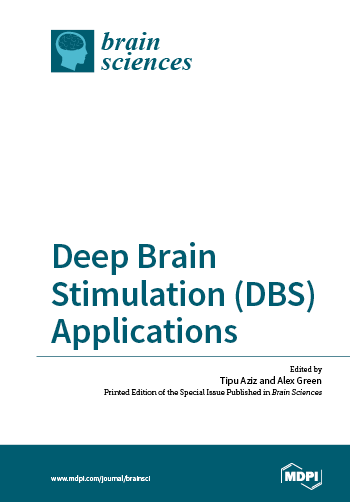Deep Brain Stimulation (DBS) Applications
A special issue of Brain Sciences (ISSN 2076-3425).
Deadline for manuscript submissions: closed (30 June 2016) | Viewed by 128014
Special Issue Editors
Interests: Parkinson’s disease; movement disorders; pain; functional neurosurgery
Special Issues, Collections and Topics in MDPI journals
Interests: deep brain stimulation; spinal cord stimulation; neuromodulation; pain; autonomic; movement disorders
Special Issues, Collections and Topics in MDPI journals
Special Issue Information
Dear Colleagues,
We would like to invite you to contribute an article to a Special Issue of Brain Sciences. The issue is dedicated to applications of Deep Brain Stimulation and, in this issue, we would like to highlight the new developments that are taking place in the field. These include the application of new technology to existing indications, as well as ‘new’ indications. We would also like to highlight the most recent clinical evidence from international multicentre trials. The issue will include articles relating to movement disorders, pain, psychiatric indications, as well as emerging indications that are not yet accompanied by clinical evidence. We look forward to your expert contribution to this exciting issue.
Prof. Dr. Tipu Aziz
Dr. Alex Green
Guest Editors
Manuscript Submission Information
Manuscripts should be submitted online at www.mdpi.com by registering and logging in to this website. Once you are registered, click here to go to the submission form. Manuscripts can be submitted until the deadline. All submissions that pass pre-check are peer-reviewed. Accepted papers will be published continuously in the journal (as soon as accepted) and will be listed together on the special issue website. Research articles, review articles as well as short communications are invited. For planned papers, a title and short abstract (about 100 words) can be sent to the Editorial Office for announcement on this website.
Submitted manuscripts should not have been published previously, nor be under consideration for publication elsewhere (except conference proceedings papers). All manuscripts are thoroughly refereed through a single-blind peer-review process. A guide for authors and other relevant information for submission of manuscripts is available on the Instructions for Authors page. Brain Sciences is an international peer-reviewed open access monthly journal published by MDPI.
Please visit the Instructions for Authors page before submitting a manuscript. The Article Processing Charge (APC) for publication in this open access journal is 2200 CHF (Swiss Francs). Submitted papers should be well formatted and use good English. Authors may use MDPI's English editing service prior to publication or during author revisions.
Keywords
- Deep Brain Stimulation
- Movement Disorders
- Pain
- Novel Technology








